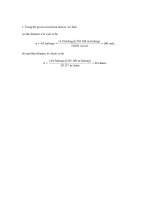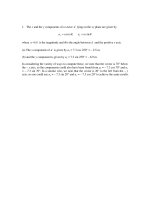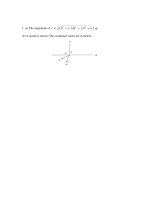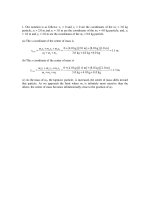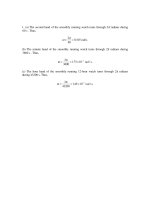Solution manual fundamentals of physics extended, 8th editionch07
Bạn đang xem bản rút gọn của tài liệu. Xem và tải ngay bản đầy đủ của tài liệu tại đây (685.34 KB, 80 trang )
1. With speed v = 11200 m/s, we find
K=
1 2 1
mv = (2.9 × 105 ) (11200) 2 = 18
. × 1013 J.
2
2
2. (a) The change in kinetic energy for the meteorite would be
(
)(
1
1
∆K = K f − K i = − K i = − mi vi2 = − 4 × 106 kg 15 × 103 m/s
2
2
)
2
= −5 × 1014 J ,
or | ∆K |= 5 × 1014 J . The negative sign indicates that kinetic energy is lost.
(b) The energy loss in units of megatons of TNT would be
§ 1 megaton TNT ·
−∆K = ( 5 × 1014 J ) ¨
¸ = 0.1megaton TNT.
15
© 4.2 × 10 J ¹
(c) The number of bombs N that the meteorite impact would correspond to is found by
noting that megaton = 1000 kilotons and setting up the ratio:
N=
0.1 × 1000 kiloton TNT
= 8.
13kiloton TNT
3. (a) From Table 2-1, we have v 2 = v02 + 2a∆x . Thus,
v = v02 + 2a∆x =
( 2.4 × 10 )
7 2
+ 2 ( 3.6 × 1015 ) ( 0.035) = 2.9 × 107 m/s.
(b) The initial kinetic energy is
Ki =
2
1 2 1
mv0 = (1.67 × 10−27 kg )( 2.4 × 107 m/s ) = 4.8 × 10−13 J.
2
2
The final kinetic energy is
Kf =
2
1 2 1
mv = (1.67 × 10−27 kg )( 2.9 × 107 m/s ) = 6.9 × 10−13 J.
2
2
The change in kinetic energy is ∆K = (6.9 × 10–13 – 4.8 × 10–13) J = 2.1 × 10–13 J.
4. We apply the equation x(t ) = x0 + v0t + 12 at 2 , found in Table 2-1. Since at t = 0 s, x0 = 0
and v0 = 12 m/s , the equation becomes (in unit of meters)
x(t ) = 12t + 12 at 2 .
With x = 10 m when t = 1.0 s , the acceleration is found to be a = − 4.0 m/s 2 . The fact
that a < 0 implies that the bead is decelerating. Thus, the position is described by
x(t ) = 12t − 2.0t 2 . Differentiating x with respect to t then yields
v(t ) =
dx
= 12 − 4.0t .
dt
Indeed at t =3.0 s, v(t = 3.0) = 0 and the bead stops momentarily. The speed at t = 10 s is
v(t = 10) = − 28 m/s , and the corresponding kinetic energy is
K=
1 2 1
mv = (1.8 × 10− 2 kg)( − 28 m/s) 2 = 7.1 J.
2
2
5. We denote the mass of the father as m and his initial speed vi. The initial kinetic energy
of the father is
Ki =
1
Kson
2
and his final kinetic energy (when his speed is vf = vi + 1.0 m/s) is K f = Kson . We use
these relations along with Eq. 7-1 in our solution.
(a) We see from the above that Ki = 21 K f which (with SI units understood) leads to
1 2 1 ª1
2º
mvi = « m ( vi + 1.0 ) » .
2
2 ¬2
¼
The mass cancels and we find a second-degree equation for vi :
1 2
1
vi − vi − = 0.
2
2
The positive root (from the quadratic formula) yields vi = 2.4 m/s.
b
g
1 F 1 F mI
I
= G G Jv J
K
2 H2 H 2K
(b) From the first relation above Ki = 21 Kson , we have
1 2
mvi
2
2
son
and (after canceling m and one factor of 1/2) are led to vson = 2vi = 4.8 m s.
6. By the work-kinetic energy theorem,
W = ∆K =
(
)
1 2 1 2 1
mv f − mvi = (2.0 kg) (6.0 m/s) 2 − (4.0 m/s) 2 = 20 J.
2
2
2
&
&
We note that the directions of v f and vi play no role in the calculation.
7. Eq. 7-8 readily yields (with SI units understood)
W = Fx ∆x + Fy ∆y = 2cos(100º)(3.0) + 2sin(100º)(4.0) = 6.8 J.
8. Using Eq. 7-8 (and Eq. 3-23), we find the work done by the water on the ice block:
& &
W = F ⋅ d = 210 ˆi − 150 ˆj ⋅ 15 ˆi − 12ˆj = (210) (15) + (−150) (−12) = 5.0 ×103 J.
(
)(
)
9. Since this involves constant-acceleration motion, we can apply the equations of Table
2-1, such as x = v0t + 21 at 2 (where x0 = 0 ). We choose to analyze the third and fifth
points, obtaining
1
0.2 m = v0 (1.0 s) + a (1.0 s) 2
2
1
0.8m = v0 (2.0 s) + a (2.0 s) 2
2
Simultaneous solution of the equations leads to v0 = 0 and a = 0.40 m s2 . We now have
two ways to finish the problem. One is to compute force from F = ma and then obtain the
work from Eq. 7-7. The other is to find ∆K as a way of computing W (in accordance
with Eq. 7-10). In this latter approach, we find the velocity at t = 2.0 s from
v = v0 + at (so v = 0.80 m s) . Thus,
W = ∆K =
1
(3.0 kg) (0.80 m/s) 2 = 0.96 J.
2
10. The change in kinetic energy can be written as
∆K =
1
1
m(v 2f − vi2 ) = m(2a∆ x) = ma∆ x
2
2
where we have used v 2f = vi2 + 2a∆ x from Table 2-1. From Fig. 7-27, we see that
∆ K = (0 − 30) J = − 30 J when ∆ x = + 5 m . The acceleration can then be obtained as
a=
∆K
(− 30 J)
=
= − 0.75 m/s 2 .
m∆ x (8.0 kg)(5.0 m)
The negative sign indicates that the mass is decelerating. From the figure, we also see
that when x = 5 m the kinetic energy becomes zero, implying that the mass comes to rest
momentarily. Thus,
v02 = v 2 − 2a∆ x = 0 − 2(− 0.75 m/s 2 )(5.0 m) = 7.5 m 2 /s 2 ,
or v0 = 2.7 m/s . The speed of the object when x = −3.0 m is
v = v02 + 2a∆ x = 7.5 + 2(− 0.75)(− 3.0) = 12 = 3.5 m/s .
&
&
11. We choose +x as the direction of motion (so a and F are negative-valued).
&
(a) Newton’s second law readily yields F = (85 kg) ( − 2.0 m/s 2 ) so that
&
F =| F | = 1.7 × 102 N .
(b) From Eq. 2-16 (with v = 0) we have
0 = v + 2a∆x ∆x = −
2
0
( 37 m/s )
(
2
2 −2.0 m/s
2
)
= 3.4 × 102 m .
Alternatively, this can be worked using the work-energy theorem.
&
&
(c) Since F is opposite to the direction of motion (so the angle φ between F and
&
d = ∆x is 180°) then Eq. 7-7 gives the work done as W = − F ∆x = −5.8 × 104 J .
&
(d) In this case, Newton’s second law yields F = ( 85kg ) ( −4.0 m/s2 ) so that
&
F =| F | = 3.4 ×10 2 N .
(e) From Eq. 2-16, we now have
∆x = −
( 37 m/s )
2
2 ( −4.0 m/s
2
)
= 1.7 × 102 m.
&
(f) The force F is again opposite to the direction of motion (so the angle φ is again 180°)
so that Eq. 7-7 leads to W = − F ∆x = −5.8 × 104 J. The fact that this agrees with the result
of part (c) provides insight into the concept of work.
12. (a) From Eq. 7-6, F = W/x = 3.00 N (this is the slope of the graph).
(b) Eq. 7-10 yields K = Ki + W = 3.00 J + 6.00 J = 9.00 J.
13. (a) The forces are constant, so the work done by any one of them is given by
&
&
& &
W = F ⋅ d , where d is the displacement. Force F1 is in the direction of the displacement,
so
W1 = F1d cos φ1 = (5.00 N) (3.00 m) cos 0° = 15.0 J.
&
Force F2 makes an angle of 120° with the displacement, so
W2 = F2 d cos φ2 = (9.00 N) (3.00 m) cos120° = −13.5 J.
&
Force F3 is perpendicular to the displacement, so W3 = F3d cos φ3 = 0 since cos 90° = 0.
The net work done by the three forces is
W = W1 + W2 + W3 = 15.0 J − 13.5 J + 0 = +1.50 J.
(b) If no other forces do work on the box, its kinetic energy increases by 1.50 J during the
displacement.
14. The forces are all constant, so the total work done by them is given by W = Fnet ∆x ,
where Fnet is the magnitude of the net force and ∆x is the magnitude of the displacement.
We add the three vectors, finding the x and y components of the net force:
Fnet x = − F1 − F2 sin 50.0° + F3 cos 35.0° = −3.00 N − (4.00 N)sin 35.0° + (10.0 N) cos 35.0°
= 2.13 N
Fnet y = − F2 cos 50.0° + F3 sin 35.0° = −(4.00 N) cos50.0° + (10.0 N) sin 35.0°
= 3.17 N.
The magnitude of the net force is
2
Fnet = Fnet2 x + Fnet
(2.13) 2 + (3.17) 2 = 3.82 N.
y =
The work done by the net force is
W = Fnet d = (3.82 N) (4.00 m) = 15.3 J
& &
where we have used the fact that d || Fnet (which follows from the fact that the canister
started from rest and moved horizontally& under the action of horizontal forces — the
resultant effect of which is expressed by Fnet ).
15. Using the work-kinetic energy theorem, we have
& &
∆ K = W = F ⋅ d = Fd cos φ
In addition, F = 12 N and d = (2.00) 2 + (− 4.00) 2 + (3.00)2 = 5.39 m .
(a) If ∆ K = + 30.0 J , then
·
30.0
§ ∆K ·
−1 §
¸ = 62.3 ° .
¸ = cos ¨
© Fd ¹
© (12.0)(5.39) ¹
φ = cos − 1 ¨
(b) ∆ K = − 30.0 J , then
− 30.0 ·
§ ∆K ·
−1 §
¸ = 118 °
¸ = cos ¨
© Fd ¹
© (12.0)(5.39) ¹
φ = cos − 1 ¨
16. In both cases, there is no acceleration, so the lifting force is equal to the weight of the
object.
& &
(a) Eq. 7-8 leads to W = F ⋅ d = (360 kN) (0.10 m) = 36 kJ.
(b) In this case, we find W = (4000 N)(0.050 m) = 2.0 × 102 J .
&
17. (a) We use F to denote the upward force exerted by the cable on the astronaut. The
force of the cable is upward and the force of gravity is mg downward. Furthermore, the
acceleration of the astronaut is g/10 upward. According to Newton’s second law, F – mg
&
&
= mg/10, so F = 11 mg/10. &Since the force F and the displacement d are in the same
direction, the work done by F is
c
h
2
11mgd 11 (72 kg) 9.8 m / s (15 m)
WF = Fd =
=
= 1164
.
× 104 J
10
10
which (with respect to significant figures) should be quoted as 1.2 × 104 J.
(b) The force of gravity has magnitude mg and is opposite in direction to the
displacement. Thus, using Eq. 7-7, the work done by gravity is
c
h
Wg = − mgd = − (72 kg) 9.8 m / s2 (15 m) = − 1058
.
× 104 J
which should be quoted as – 1.1 × 104 J.
(c) The total work done is W = 1164
.
× 104 J − 1.058 × 104 J = 1.06 × 103 J . Since the
astronaut started from rest, the work-kinetic energy theorem tells us that this (which we
round to 1.1 ×103 J ) is her final kinetic energy.
(d) Since K = 21 mv 2 , her final speed is
. × 103 J)
2K
2(106
v=
=
= 5.4 m / s.
72 kg
m
18. (a) Using notation common to many vector capable calculators, we have (from Eq. 78) W = dot([20.0,0] + [0, −(3.00)(9.8)], [0.500 ∠ 30.0º]) = +1.31 J.
(b) Eq. 7-10 (along with Eq. 7-1) then leads to
v = 2(1.31 J)/(3.00 kg) = 0.935 m/s.
19. (a) We use F to denote the magnitude of the force of the cord on the block. This force
is upward, opposite to the force of gravity (which has magnitude Mg). The acceleration is
&
a = g / 4 downward. Taking the downward direction to be positive, then Newton’s second
law yields
FG IJ
H K
&
g
&
Fnet = ma Mg − F = M
4
so F = 3Mg/4. The displacement is downward, so the work done by the cord’s force is,
using Eq. 7-7,
WF = –Fd = –3Mgd/4.
(b) The force of gravity is in the same direction as the displacement, so it does work
Wg = Mgd .
(c) The total work done on the block is −3 M gd 4 + M gd = M gd 4 . Since the block
b
g
starts from rest, we use Eq. 7-15 to conclude that this M gd 4 is the block’s kinetic
energy K at the moment it has descended the distance d.
(d) Since K = 12 Mv 2 , the speed is
v=
2K
2( Mgd / 4)
=
=
M
M
at the moment the block has descended the distance d.
gd
2
&
20. The fact that the applied force Fa causes the box to move up a frictionless ramp at a
constant speed implies that there is no net change in the kinetic energy: ∆ K = 0 . Thus,
&
the work done by Fa must be equal to the negative work done by gravity: Wa = −Wg .
Since the box is displaced vertically upward by h = 0.150 m , we have
Wa = + mgh = (3.00)(9.80)(0.150) = 4.41 J
21. Eq. 7-15 applies, but the wording of the problem suggests that it is only necessary to
examine the contribution from the rope (which would be the “Wa” term in Eq. 7-15):
Wa = −(50 N)(0.50 m) = −25 J
(the minus sign arises from the fact that the pull from the rope is anti-parallel to the
direction of motion of the block). Thus, the kinetic energy would have been 25 J greater
if the rope had not been attached (given the same displacement).
22. We use d to denote the magnitude of the spelunker’s displacement during each stage.
The mass of the spelunker is m = 80.0 kg. The work done by the lifting force is denoted
Wi where i = 1, 2, 3 for the three stages. We apply the work-energy theorem, Eq. 17-15.
(a) For stage 1, W1 − mgd = ∆K1 = 21 mv12 , where v1 = 5.00 m / s . This gives
1
1
W1 = mgd + mv12 = (80.0) (9.80) (10.0) + (8.00)(5.00)2 = 8.84 ×103 J.
2
2
(b) For stage 2, W2 – mgd = ∆K2 = 0, which leads to
W2 = mgd = (80.0 kg) ( 9.80 m/s 2 ) (10.0 m) = 7.84 ×103 J.
(c) For stage 3, W3 − mgd = ∆K3 = − 21 mv12 . We obtain
1
1
W3 = mgd − mv12 = (80.0) (9.80) (10.0) − (80.0)(5.00)2 = 6.84 × 103 J.
2
2
23. (a) The net upward force is given by
F + FN − (m + M ) g = (m + M )a
where m = 0.250 kg is the mass of the cheese, M = 900 kg is the mass of the elevator cab,
F is the force from the cable, and FN = 3.00 N is the normal force on the cheese. On the
cheese alone, we have
FN − mg = ma a =
3.00 − (0.250)(9.80)
= 2.20 m/s 2 .
0.250
Thus the force from the cable is F = (m + M )(a + g ) − FN = 1.08 ×10 4 N , and the work
done by the cable on the cab is
W = Fd1 = (1.80 × 104 )(2.40) = 2.59 × 104 J.
(b) If W = 92.61 kJ and d 2 = 10.5 m , the magnitude of the normal force is
FN = (m + M ) g −
W
9.261× 104
= (0.250 + 900)(9.80) −
= 2.45 N.
d2
10.5
24. The spring constant is k = 100 N/m and the maximum elongation is xi = 5.00 m.
Using Eq. 7-25 with xf = 0, the work is found to be
W=
1 2 1
kxi = (100)(5.00) 2 = 125
. × 103 J.
2
2
25. We make use of Eq. 7-25 and Eq. 7-28 since the block is stationary before and after
the displacement. The work done by the applied force can be written as
Wa = −Ws =
1
k ( x 2f − xi2 ) .
2
The spring constant is k = (80 N) /(2.0 cm)=4.0 × 103 N/m. With Wa = 4.0 J , and
xi = − 2.0 cm , we have
xf = ±
2Wa
2(4.0 J)
+ xi2 = ±
+ (− 0.020 m) 2 = ± 0.049 m = ± 4.9 cm.
k
(4.0 ×103 N/m)
